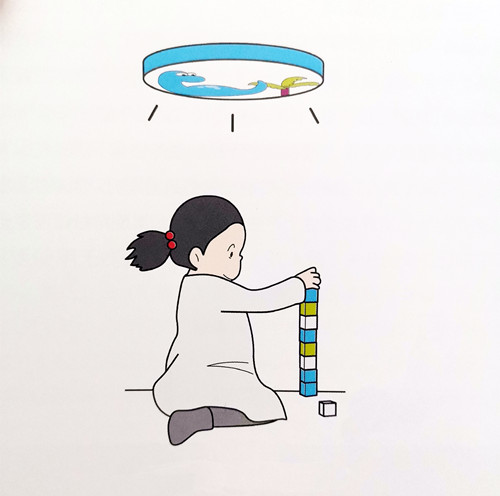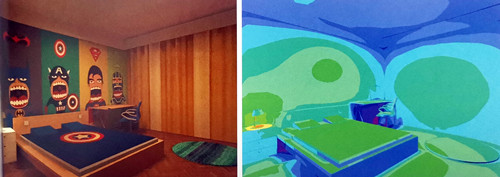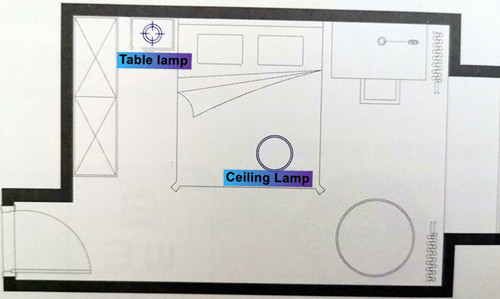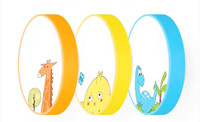- 08
- Aug
Creating an Enriching Lighting Environment for Children’s Spaces: Design, Impact, and Smart Solutions
Creating an Enriching Lighting Environment for Children’s Spaces: Design, Impact, and Smart Solutions
The theme we’re discussing today is crystal clear. As our devoted fans, we’ve compiled a set of fans questions that have caught our attention.
Here’s the summary:
What type of lighting is most suitable for children?
Why does lighting play a crucial role in a nursery?
How does light affect children?
What’s the best way to illuminate a kids’ room?
Are LED lights safe for children?
What constitutes optimal lighting for a child’s bedroom?
Is investing in intelligent lighting worthwhile?
Have you ever pondered these questions? If you have, let’s consider your identity. Are you a lighting designer or a lighting engineer?
The questions mentioned above are tailored for us to provide explanations to end consumers. Today, I’m sharing this information from a forward-looking and in-depth perspective. This approach significantly enhances your business acumen and professional expertise, ultimately serving as a key factor in securing orders.
In this blog post, we will guide you through the key elements of intelligent control systems, interactive experiences, and facilitating children’s participation. We’ll explore the profound impact of lighting in children’s spaces, leading to an in-depth discussion about the design principles, effects, intelligent solutions, and safety considerations when creating a vibrant lighting environment in children’s spaces that fosters both creativity and practical application. Are you prepared?
Designing Children’s Lighting: Enhancing Independent Living for Kids
As children transition from infant to school age, they spend a significant portion of their time at home. To foster their independence, parents often allocate separate rooms for their children. In the past, when decorating children’s rooms, parents primarily focused on selecting a decorative style and incorporating vibrant colors and various cartoon shapes to infuse the space with a sense of childlike delight. While aesthetics played a role, ensuring health and safety was paramount. Factors such as the eco-friendliness of materials (such as adherence to formazan standards), protective measures for play areas, and especially the prevention of electrical hazards were critical concerns.
Interestingly, the design of window shades in children’s rooms also demands attention. This aspect holds substantial significance for preschool children who are undergoing physical and psychological growth (see Figure 1).

1. Effects of the Light Environment on Children
1.1 Providing a Sense of Security through Night Lighting
Parents have always emphasized children’s self-reliance. The primary objective of designing a children’s room is to offer youngsters a space where they can develop their independence. This space enables them to learn to fall asleep on their own, without the need for parental presence. Additionally, it facilitates the cultivation of independent sleeping habits, ensuring that they can navigate waking up during the night without relying on family members.
Despite this intention, many children across families find it challenging to adapt to sleeping alone initially. To address this, incorporating dim lighting while the child falls asleep can help alleviate their fear of the dark environment. Furthermore, a beneficial strategy involves gradually dimming the light as the child drifts into slumber. This gentle transition ensures that the room becomes adequately dark over time, thereby preserving the child’s uninterrupted rest.
1.2 Impact of Sudden Changes in Brightness on Brain Development
As a child initially falls asleep, the dark environment triggers the release of melatonin, facilitating a gradual transition into slumber and allowing the brain to rest fully. However, during nighttime awakenings, the brightness of conventional lighting products (with fixed brightness and color temperature) tends to be quite high. This sudden exposure to a significantly brighter environment from the darkness can abruptly awaken individuals. Such rapid fluctuations in light intensity can jolt the resting brain back into an active state.
When these sudden brightness changes occur frequently, they can exert a detrimental influence, particularly on children during crucial stages of brain development. The disturbances in their sleep caused by frequent awakenings can impede the brain’s natural progression and potentially lead to negative consequences.
1.3 Impact on Children’s Safety During Activities
Preschool-aged children are naturally inclined to engage in various activities such as playing, running, jumping, reading, crawling, and playing games throughout every corner of their rooms. Consequently, when designing rooms for preschoolers, it’s imperative to consider how lighting design can contribute to their safety. The presence of poorly lit or insufficiently bright areas in the room can potentially lead to obstacles during their activities, resulting in falls.
Some parents prioritize safety and intentionally position switches in areas difficult for children to reach. Conversely, other parents desire to encourage their children’s independence, hoping they can operate lights autonomously. However, the fixed placement of traditional 86-box switches often proves inaccessible to many preschoolers. This creates a dilemma between ensuring lighting safety and fostering self-sufficiency.
By incorporating wireless switches that can be installed anywhere, this dilemma can be resolved. Such switches empower children to easily control lighting (see Figure 2), striking a balance between safety and the development of independence.

2. Principles of Children’s Room Lighting Design
2.1 Ensuring Comprehensive Illumination and Accessible Fixtures
When crafting a tailored lighting environment for children, it becomes essential to consider not only functionality and safety but also the incorporation of elements that captivate children’s interests, thereby making their room appealing. Much like infants, the eyes of preschoolers are not fully developed, rendering them highly sensitive to intense illumination. Consequently, it’s advisable to refrain from installing downlight spotlights in children’s rooms. Instead, opt for a combination of ceiling lamps and led strips light.
The lighting scheme for children’s rooms should prioritize uniform brightness while eliminating any dark corners. This design approach ensures that children can move and play within a well-lit environment. To prevent accidents during activities, minimize the usage of floor lamps which may pose tripping hazards due to their wires. Furthermore, meticulous attention must be directed toward lamp selection. It is imperative to avoid lamps with high surface temperatures, as this precaution is necessary to prevent potential burns in children.
2.2 Incorporating Delayed Turn-off Feature in Lighting
The inclusion of a delayed turn-off function in smart lamps proves highly advantageous when designing lighting scenes for children’s rooms. For instance, envision a scenario where the lighting setting for accompanying a child’s sleep is configured. The gentle, moonlight-like illumination accompanies the child into slumber. This subdued lighting helps dispel any fear that might arise in a completely dark environment.
Subsequently, as the child gradually falls asleep, the light will automatically dim and eventually turn off, maintaining a sufficiently dark room conducive to uninterrupted rest. Furthermore, upon the child’s return to bed after awakening during the night, the pre-set automatic delay time can trigger the light to turn off automatically. This feature ensures that the child swiftly returns to slumber after a brief period of activity, promoting a seamless transition to rest.
2.3 Flexible Utilization of Wireless Switches
During the cognitive development phase, preschool children exhibit strong curiosity and a penchant for exploring various aspects of their surroundings. Parents can facilitate the cultivation of good habits and enhance their hands-on capabilities by encouraging children to learn to switch control on their own initiative. Nonetheless, the fixed height of conventional 86-box switches often renders them inaccessible to preschoolers.
In the context of the lighting design depicted in Figure 3 , a wall-mountable Bluetooth wireless switch can be affixed at the entrance of the children’s room, positioned according to the child’s height. This arrangement enables children to access the switch without assistance or even by stretching on tiptoe. The wall-mount version of the wireless switch features a thin velcro backing, eliminating the need for complex installation and wiring. This design allows it to be easily mounted in various locations to cater to the diverse age range of children.
Additionally, a Bluetooth wireless switch can be placed in close proximity to the bedside—on the bedside table or another easily reachable spot. This arrangement permits the child to operate the switch without needing to leave the bed, whether it’s to turn off the light before falling asleep or to activate it upon waking in the middle of the night.

2.4 Daylight Wake-Up for Timely Rising
In Section “Guide to Smart Lighting Design: Light Alarm Clock”, we delve into the significance of the light environment and natural light’s impact on human biorhythms during the awakening process. This holds exceptional relevance, particularly for preschoolers. It’s noteworthy that some families opt for heavy blackout curtains in their children’s rooms. Yet, a consequence of this choice arises when children wake up, open the curtains, and transition abruptly from darkness to daylight. This transition can hinder the development of a sense of day and night for children during their growth phase, subsequently influencing their biological clocks.
To mitigate this issue, employing a smart ceiling light in your child’s room can prove highly effective. This solution allows you to program a timed sunrise mode. Upon reaching the scheduled time, the smart ceiling light gradually intensifies its brightness, emulating the natural progression of light as the sun rises. This gentle awakening experience helps rouse the child from slumber in a soothing manner. Furthermore, it aids in fostering constructive daily routines, encouraging children to develop consistent waking habits.
3. Essential Smart Lighting Modes for Children’s Rooms
3.1 Moonlight Mode: Creating a Soothing Bedtime Atmosphere
The “Moonlight mode” serves as an ideal sleep setting tailored for preschool children. This mode envelops them in a gentle and moonlit-like ambiance, facilitating swift and comfortable slumber. Within this softly illuminated environment, children can easily transition into sleep. The smart ceiling lamp incorporates a designated “Moonlight mode,” characterized by a light with a color temperature of 2700 K and a brightness level of 1% (see Figure 4).

To activate the “Moonlight mode,” the child can initiate it by double-clicking the Bluetooth wireless switch located at the head of the bed. Subsequently, a brief double press of the Bluetooth wireless switch can activate the delayed light-off function. This delay can be predetermined based on the child’s biological clock patterns. For example, after 20 minutes in the moonlight mode, the light gradually diminishes until it eventually turns off, ensuring a seamless transition into sleep.
3.2 Wake-Up Mode: Nurturing Independent Nighttime Routines
A majority of smart lighting solutions encompass a “night light mode” designed to cater to nocturnal lighting requirements. This mode features subdued brightness and a low color temperature, ideally suited for nighttime illumination. For instance, it can be programmed to activate between 22:00 and 6:00 the following morning. During nighttime awakenings, children possess the option to trigger the night light mode either by using the wireless switch located near their bedhead or by the automatic activation of the human body sensor. As a result, when children awaken at night, they encounter an environment characterized by a soft color temperature and gentle illumination (refer to Figure 5).

Subsequent to their nocturnal activities, children can manually deactivate the bedside switch. Alternatively, they can preconfigure the “automatic delay for light-off” setting. This configuration ensures that the light will turn off automatically after a predetermined time, facilitating a smooth transition back to slumber after brief periods of activity.
3.3 Wake-Up Mode: Instilling Consistent Daily Routines
Children’s ceiling lamps are equipped with an integrated “daylight algorithm.” Similar to adults, children also benefit from a specialized “wake-up mode” that aligns with their natural circadian rhythm. This mode (as depicted in Figure 6) replicates the progression of a natural day, aiding in the cultivation of a reliable habit of waking up at an appropriate time. This approach proves more effective than relying on traditional alarm clocks, as it resonates better with children’s biological rhythms and encourages them to rise voluntarily on schedule.

4. Step by step, create a unique lighting environment for children.
Step 1: Designing the Lighting Setup
To begin, design the layout of the lighting points. Figure 7 provides a location map illustrating the arrangement of children’s ceiling lamps within the room. These lamps are equipped with comprehensive functionalities. Through either a Bluetooth wireless switch or a human body sensor, they offer features like moonlight mode, night mode, and wake-up mode. The subsequent sections will elaborate on the various ways to utilize these capabilities.

Step 2: Purchasing Lamps and Smart Linkage Equipment
Refer to Table 4.2 and Table 4.3 for the relevant specifications of the children’s ceiling lamp and the Bluetooth wireless switch. These tables will aid in selecting and acquiring the appropriate lamps and smart linkage equipment.
|
Lamp Name |
Lamp Size (mm) | Power (W) | Color Temperature (K) | Lamp Image |
| Smart children’s ceiling lamp | Φ 320 * 73 | 28 | 2700-5700 |
|
Device name |
Function | Basic Parameters |
Product Image |
|
Smart Wireless Dimmer Switch (SMT Version) |
Intelligent dimming |
Wireless connectivity: BLE 4.2 Battery life: 50 times a day, can be used for two years Standby time: 3 years |
|
Step 3: Configuring Lighting and Intelligent Linkage Rules
Follow these sub-steps to establish the necessary rules for lighting and intelligent device coordination:
Integrate Devices into the Smart Home System: Connect the lamps and smart linkage devices to your smart home system as per the product’s usage instructions.
Pair the Wireless Dimmer Switch: Utilize the app’s instructions to successfully pair the wireless dimmer switch with the children’s ceiling lamp.
Activate “Sunrise Wake” and “Daylight Algorithm”: Turn on the “Sunrise Wake” function, as explained in Section “Guide to Smart Lighting Design: Light Alarm Clock”. Additionally, enable the “Daylight Algorithm” function.
Enable “Delayed Light Off”: Within the app, activate the “delayed light off” function for the children’s ceiling lamp. Specify a time for the delayed light to turn off, such as 15 minutes.
Activate Night Light Function: Configure the “Night Light Mode” by setting its activation and deactivation times according to the children’s schedule and their sleep routines. Also, determine a suitable delay time for the light to turn off.
Our goal is to assist you in thoroughly exploring the diverse aspects of establishing enriching lighting environments in children’s spaces. If you’re interested in developing a comprehensive and diverse resource about lighting environments in children’s spaces – encompassing technical and design intricacies, social implications, and children’s involvement – please don’t hesitate to reach out. We are more than willing to share with you. We possess a collection of lighting design case studies from children’s spaces across various cultures and regions, with a specific focus on lighting requirements and solutions in special environments such as hospitals, kindergartens, and special education institutions.
Are you still hesitating to get in touch with me, especially considering the changing landscape of customer purchasing requirements?
Regarding children’s smart lighting solutions, it’s essential to understand how to implement this solution, along with hardware and software considerations…
I can be completely candid with you: our database analysis indicates that we’ve been contacted by over 100+ clients from around the world this year. What does this signify? I’m sure you’re well aware. Are you ready to seize the front-end opportunity and retain customers?


